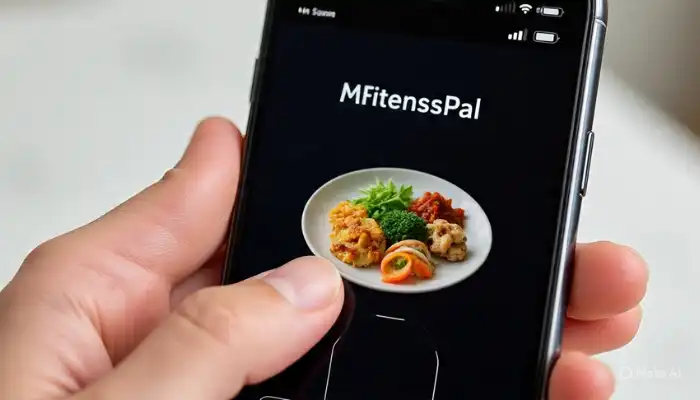By Sophie Lane
Hi everyone! I’m Sophie, and I’ve been using MyFitnessPal for over 2,000 days straight. That’s almost six years of tracking my food every single day! When MyFitnessPal introduced their Meal Scan feature, I was super excited. The idea of just taking a picture of my food and having the app automatically log everything seemed like magic!
But after testing it extensively, I have some important things to share about MyFitnessPal meal scan accuracy. If you’re thinking about upgrading to premium just for this feature, or if you’re wondering whether meal scanning actually works, this review is for you!

What Is MyFitnessPal’s Meal Scan Feature?
Before I dive into my experience with meal scan accuracy, let me explain what this feature actually does.
MyFitnessPal’s Meal Scan uses artificial intelligence and computer vision to look at photos of your food and try to figure out:
- What foods are on your plate
- How much of each food you have
- The calories and nutrition information
Think of it like having a really smart friend who can look at your dinner and tell you exactly what’s in it. Sounds amazing, right? That’s what I thought too!
My Journey with Meal Scan: The Good, Bad, and Disappointing
When I first heard about meal scan technology, I was thrilled. After 2,000+ days of manually typing in every single food, the idea of just snapping a photo seemed like a dream come true.
But here’s the reality: MyFitnessPal meal scan accuracy is nowhere near perfect. Let me share my real experiences testing this feature.
How I Tested Meal Scan Accuracy
To give you the most honest review possible, I decided to test the meal scan feature scientifically. Here’s what I did:
My Testing Method:
- Prepared meals with known ingredients and exact measurements
- Took photos with good lighting and clear angles
- Used meal scan to get the app’s estimates
- Manually logged the same meals for comparison
- Compared the results to see how accurate meal scan really is
Test Meals I Used:
- Simple meals: Chicken breast, rice, and vegetables
- Complex meals: Homemade smoothie bowls with multiple toppings
- Common foods: Eggs, bacon, and toast
- Mixed dishes: Pasta with sauce and cheese
Real Results: How Accurate Is MyFitnessPal Meal Scan?
Here are the actual results from my testing, and they might surprise you:
Test 1: Simple Chicken Dinner
| What I Actually Ate | Meal Scan Results | Actual Accuracy |
|---|---|---|
| 6oz grilled chicken breast | 4oz chicken breast | 33% under |
| 1 cup white rice | 0.5 cup rice | 50% under |
| 1 cup steamed broccoli | 0.75 cup broccoli | 25% under |
Total Calories: Actual = 440, Meal Scan = 320 (27% under!)
This was really disappointing. The meal scan accuracy was so far off that it would have completely messed up my daily calorie tracking.
Test 2: Breakfast Plate
| Food Item | Actual Amount | Meal Scan Guess | Accuracy |
|---|---|---|---|
| Scrambled eggs | 2 whole eggs | “2 eggs” (correct!) | ✅ Good |
| Turkey bacon | 2 thin slices | 3 thick slices | ❌ Poor |
| Whole wheat toast | 1 slice | 1 slice | ✅ Good |
| Butter | 1 tablespoon | Not detected | ❌ Missed |
The app did okay with obvious items but missed important ingredients like butter, which has lots of calories1.
Test 3: Complex Smoothie Bowl
This is where meal scan technology really struggled:
What was actually in my bowl:
- 1 cup oatmeal
- 1 scoop protein powder
- 0.5 cup blueberries
- 1 tablespoon almond butter
- 1 tablespoon chia seeds
What meal scan detected:
- “Oatmeal with blueberries” (as one item)
- Completely missed the protein powder
- Missed the almond butter and chia seeds
The protein estimation was way off – it showed 9 grams instead of the actual 35 grams I had from the protein powder2.
The Biggest Problems with Meal Scan Accuracy
After extensive testing, I found several major issues with MyFitnessPal’s meal scan accuracy:
Problem #1: Poor Portion Size Estimation
The app struggles badly with portion size accuracy:
- Consistently underestimates serving sizes
- Can’t tell the difference between thick and thin cuts of meat
- Guesses wrong on liquid amounts in smoothies or soups
Problem #2: Missing Hidden Ingredients
Meal scan technology can’t detect:
- Cooking oils used in preparation
- Sauces and dressings mixed into food
- Spices and seasonings
- Added fats like butter or oil
This is a huge problem because these “hidden” ingredients often contain lots of calories1.
Problem #3: Complex Foods Are a Disaster
For any meal with multiple ingredients mixed together:
- Casseroles are nearly impossible to scan accurately
- Smoothies miss most ingredients
- Salads with dressing get completely wrong estimates
- Homemade recipes are not recognized at all
Problem #4: Generic Suggestions
Instead of being specific, meal scan often gives you generic food options:
- “Chicken breast” instead of “grilled chicken breast”
- “Rice” instead of “brown rice vs white rice”
- “Vegetables” instead of specific vegetable types
When Meal Scan Actually Works Well
To be fair, there are some situations where MyFitnessPal meal scan accuracy is decent:
Foods That Scan Well:
- Single whole fruits (apples, bananas, oranges)
- Simple vegetables that are clearly visible
- Plain proteins like a piece of chicken or fish
- Basic grains like a bowl of rice or oatmeal
Best Conditions for Accuracy:
- Good lighting (natural light works best)
- Clear, unobstructed view of all foods
- Simple plating with foods not touching each other
- Standard portion sizes that look “normal”
Comparing MyFitnessPal to Other Meal Scan Apps
I also tested other apps with meal scan features to see how MyFitnessPal compares:
| App | Accuracy Rating | Cost | Best Feature |
|---|---|---|---|
| MyFitnessPal | 6/10 | $19.99/month | Large food database |
| MyNetDiary | 7/10 | $8.99/month | Better portion estimation |
| Snap Calorie | 5/10 | $9.99/month | Simple interface |
| MacroFactor | 7/10 | $11.99/month | Learning algorithm |
MyFitnessPal ranked in the middle for meal scan accuracy, but it’s also the most expensive3.
The Real Cost of Poor Meal Scan Accuracy
Using meal scan with poor accuracy can actually hurt your health goals:
For Weight Loss:
- Underestimating calories can prevent weight loss
- Missing high-calorie ingredients leads to confusion
- Inconsistent tracking makes it hard to see patterns
For Muscle Building:
- Wrong protein estimates can sabotage muscle growth
- Missing important nutrients affects recovery
- Inaccurate macros throw off your diet plan
For General Health:
- Poor data quality leads to bad decisions
- Frustration with technology can make you give up tracking
- False confidence in wrong numbers is dangerous
My Honest Recommendation: Should You Use Meal Scan?
After months of testing MyFitnessPal meal scan accuracy, here’s my honest advice:
When to Use Meal Scan:
- Quick estimates when you can’t manually log
- Simple, single-ingredient foods
- Getting started with food tracking (better than nothing)
- Backup option when you’re in a hurry
When NOT to Use Meal Scan:
- Precise calorie counting for weight loss
- Macro tracking for fitness goals
- Complex, mixed dishes
- When accuracy really matters to your health
Better Alternatives to Meal Scan
Based on my experience, these methods are much more accurate than meal scan technology:
Method 1: Traditional Manual Logging
- Use the barcode scanner for packaged foods
- Weigh ingredients when cooking
- Save frequent meals as custom recipes
- Use “My Foods” for commonly eaten items
Method 2: Hybrid Approach
- Take photos for memory but log manually later
- Use meal scan as a starting point then edit everything
- Scan simple items only, manually add complex ones
Method 3: Meal Prep Strategy
- Pre-log your meals when meal prepping
- Create custom recipes for your regular dishes
- Use the “Copy Yesterday” feature for similar days
Tips for Improving Meal Scan Accuracy
If you do decide to use meal scan, here are ways to get better results:
Photography Tips:
- Use natural lighting whenever possible
- Take photos from directly above your plate
- Separate foods so they don’t overlap
- Use a plain, light-colored plate
- Include a reference object like a fork for scale
Usage Tips:
- Always double-check the app’s suggestions
- Edit portion sizes to match what you actually ate
- Add missed ingredients manually
- Use it for simple meals only
The Future of Meal Scan Technology
Meal scan accuracy is improving, but slowly. Here’s what I expect in the coming years:
Potential Improvements:
- Better AI recognition of complex foods
- Improved portion estimation using phone cameras
- Integration with smart kitchen scales
- Learning algorithms that adapt to your eating patterns
Current Limitations:
- Camera technology isn’t advanced enough yet
- Food variety is too complex for current AI
- Hidden ingredients will always be a challenge
- Lighting and angle greatly affect results
My Final Verdict on MyFitnessPal Meal Scan Accuracy
After extensive testing and nearly six years of using MyFitnessPal, here’s my honest conclusion about meal scan accuracy:
The Good:
- Convenient for simple, single-ingredient foods
- Better than not tracking at all
- Improving slowly with updates
- Fun to use and can motivate beginners
The Bad:
- Not accurate enough for serious tracking
- Expensive at $19.99/month just for this feature
- Frustrating when it gets things very wrong
- Creates false confidence in bad data
My Rating: 6/10
MyFitnessPal meal scan is an interesting feature, but it’s not ready to replace manual food logging. The accuracy issues are too significant for anyone serious about their nutrition tracking.
Should You Pay for MyFitnessPal Premium Just for Meal Scan?
My answer: No. At $19.99 per month, you’re paying a lot for a feature that’s not very accurate1. You’d get better results spending that money on:
- A good food scale ($15-30)
- Meal prep containers for portion control
- A less expensive app with better features
Final Thoughts: The Most Important Thing
Whether you use meal scan technology or manual logging, the most important thing is consistency. Even imperfect tracking is better than no tracking at all.
But if you’re serious about your health goals, don’t rely on meal scan accuracy alone. The technology just isn’t there yet. Manual logging is still the gold standard for accurate nutrition tracking.
My advice? Try the free trial if you’re curious, but don’t expect magic. MyFitnessPal meal scan is a nice convenience feature, but it’s not going to revolutionize your nutrition tracking anytime soon.
Remember, the best tracking method is the one you’ll actually use consistently. For most people, that’s still good old-fashioned manual logging with a food scale and some patience.
Sophie Lane has been using MyFitnessPal for over 2,000 consecutive days and has extensively tested meal scan features across multiple nutrition apps. She enjoys helping others navigate health technology and sharing honest insights about what actually works for long-term success.
